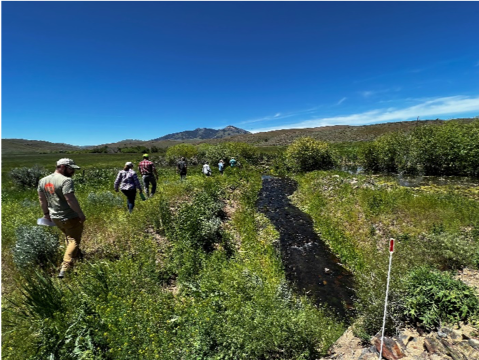Past Events
Restoring Riparian Habitats Field Training
August 28th (evening only) and 29th (full field day), 2023
Baker City, Oregon
In August 2023 SageCon hosted a workshop for those who manage or have an interest in restoring healthy creeks, streams, or rivers in Oregon rangelands, introducing a threat-based approach to stream assessment.
Thanks to those of you who joined us on August 28th for dinner and an overview of our field day and on the 29th for a full day in the field. This workshop was hosted by OSU Extension, University of Idaho Rangeland Center, US Fish & Wildlife Service, and The Nature Conservancy, introducing participants to a new guide:
Download the Manager’s Guide from the link above and review key concepts in the 50 minute video training.
Threat-based Stream Assessment
This tool rapidly assesses conditions of perennial and intermittent systems and supports the management of these mesic resources.
As a decision-support tool, threat-based assessment is not an instruction manual; it is, instead, a tool for understanding riparian function to help managers decide which riparian areas are functioning as they should, and which are not.
The intent is to provide a tool that is usable by a wide variety of natural resource professionals or land managers. This presentation will provide land managers with tools to understand relevant threats to the ecosystem, become familiar with ecological states, determine trend and ultimately prioritize areas for management actions.
Implementation Steps: Regulatory Requirements, Partners & Setting Expectations
Process-based stream restoration techniques provide land managers a low-cost, low-tech approach to improving stream and riparian habitat. However, implementing process-based restoration can still prove difficult. Many steps need to occur before implementation, including project permitting, funding, and design.
Understanding how to navigate these steps can avoid project delays and disruptions. This presentation provides a framework for taking a project from concept to application. Participants will learn how to identify and avoid common mistakes when planning a restoration project, as well as how to navigate the permitting process.
The framework will describe common funding sources, as well as typical partners who can help with the process.
Monitoring Framework & Adaptive Management
Monitoring outcomes of restoration projects is an important component that is often overlooked because of costs, time, and the difficulty of describing discrete monitoring objectives. Yet without monitoring, many projects are unable to describe if the project was a success or failure, or when maintenance or adaptive management should occur.
In process-based restoration in particular, monitoring a process rather than a designed end-state is often difficult, especially because the timeline for these processes to show significant changes can take years. This presentation will focus on how participants can conceptualize the processes they hope to engage in a restoration project and explore indicators and approaches useful for monitoring those processes


